The hungry gods of hidarugami, or Why the Japanese were afraid to go to the mountains on an empty stomach
By Pictolic https://pictolic.com/article/the-hungry-gods-of-hidarugami-or-why-the-japanese-were-afraid-to-go-to-the-mountains-on-an-empty-stomach.htmlThe Japanese bestiary of supernatural creatures can rightfully be considered one of the most eerie. The fantasy of the inhabitants of the Land of the Rising Sun has given rise to hundreds of demons, spirits and ghosts, which are more bloodthirsty and stronger than any Romanian vampires and Russian ghouls. Hidarugami (Hidarugami), literally translated "hungry gods", was considered by the people one of the most dangerous types of evil spirits and we will now tell you why.
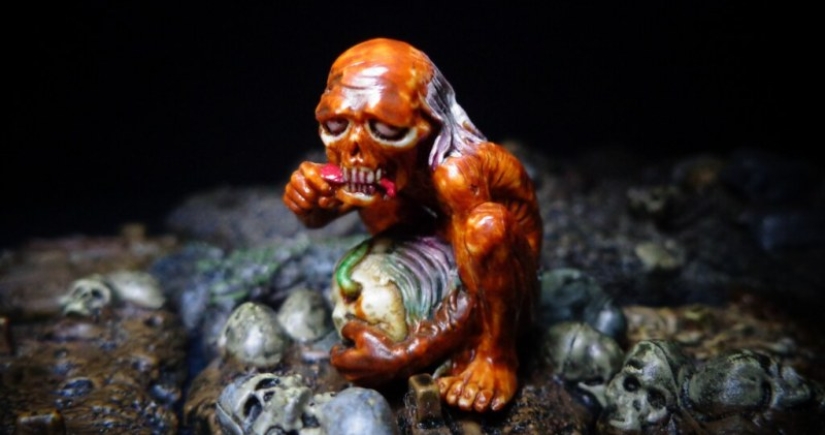
According to ancient legends, hidarugami are the souls of people who died of hunger or thirst and were not buried in accordance with Shinto rituals. The Japanese believed that if a person disappeared without a trace in the mountains, then he turned into a "hungry god", adding to the countless army of terrible, eternally searching for food spirits.
These spirits endlessly prowl the remote mountain areas from villages and cities, in search of a victim with whom to share the inexhaustible feeling of hunger. Most often, the victims of hiduragami are lonely travelers. Usually, a person before the attack of the spirit was seized by a completely unexpected and incredible feeling of hunger.
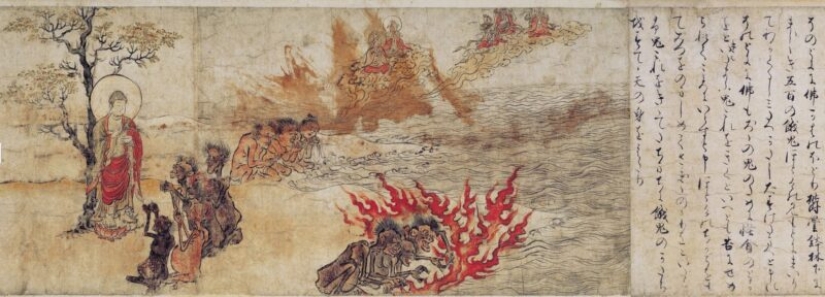
The next stage is an incredible fatigue that engulfs the traveler, because of which it becomes difficult for him to move. An exhausted person falls to the ground, not knowing what is happening, and they are completely at the mercy of a" hungry god " or even a whole gang of spirits.
At that moment, while the victim of hiduragami is still conscious, it can be helped. To do this, you just need to quickly give the person some food to drown out the unnatural hunger caused by ghosts. It was said that a few grains of rice were enough for this, but how often did a lone traveler wait for help?
A person who was not helped in time fell completely under the power of ghosts and disappeared without a trace, eaten without a trace by a pack of greedy demons. His soul also filled the ranks of hiduragami and itself became a serious source of danger for travelers.
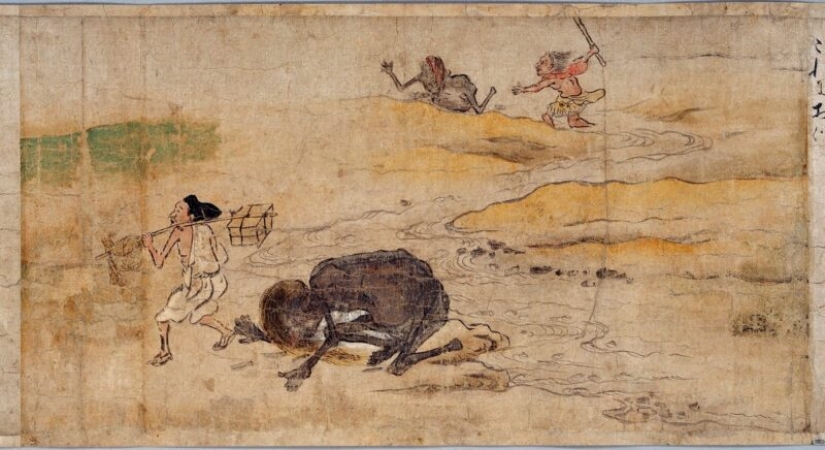
The Japanese believed that people traveling on an empty stomach were most at risk of being at the mercy of the "hungry gods". Therefore, before setting out, the prudent Japanese were well refreshed and took with them food supplies, even if the journey was not long.
Interestingly, even today, the Japanese habitually take a symbolic amount of food with them for a walk in the mountains, as a way to protect themselves from hungry spirits. Many of them can not even clearly explain what this custom is connected with, but traditions remain traditions.
Hiduragami in different areas of Japan differ from each other both in their behavior and in their demonic essence. For example, on the island of Honshu, they are considered not disembodied hungry ghosts, but quite material monsters-zombies. These monsters lie in wait for poorly eating Japanese in the mountains, forests and on the seashore, suddenly pounce from cover and begin to gnaw and devour.
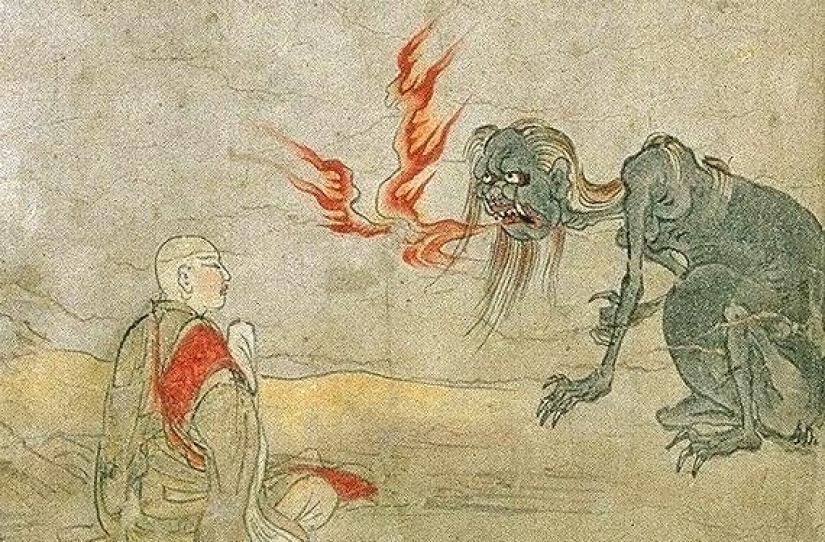
At best, the traveler remains a cripple, with a disfigured body and a dead mind, and at worst, no one will know why the traveler did not reach the end point of his route. From hiduragami island Honshu also saves food, only it needs to be thrown in the direction of the attacking zombies. Usually, rice balls were used for this purpose – a traditional dish of travelers.
The eternally hungry evil spirits are unable to ignore the food and it will immediately rush to collect and absorb it. At this time, the traveler will be able to quickly leave, if he is quick enough. Oddly enough, but quite serious documents of the 15th-18th centuries repeatedly tell us about the attacks of hiduragami on people. Of course, you can refer to the violent fantasy of superstitious Japanese, but, you will agree, it is strange when such a story gets into the official reports of police officials.
One of the most detailed cases described in the papers dates back to 1736, when a man named Senkichi almost became a victim of the "hungry gods". He was crossing a mountain range on a rarely used trail and suddenly disappeared. Concerned friends went in search of Senkichi and after a while brought him to the village.
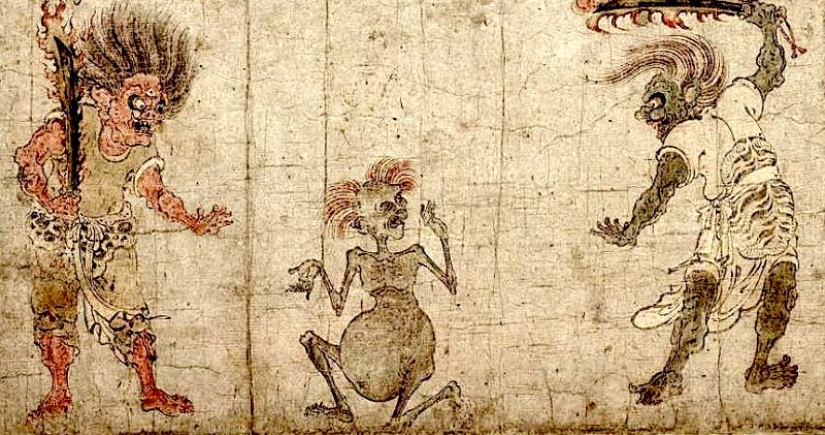
The man was very frightened and for a long time could not utter a word, but only rolled his eyes and screamed. When he calmed down, he told a terrible story about a collision with hiduragami in one of the secluded gorges. He managed to escape by throwing food supplies to the ghosts and running away without looking back. During the flight, the poor man got lost and was found with great difficulty.
In the same 18th century, a certain clerk of the village council recorded the story of a man named Mizuki Shigeru. Tom was also unlucky enough to encounter hungry spirits on the mountain road. Mizuki didn't have any rice balls with her, and only had some boiled rice in her bag. He threw it on the ground, away from him, and while the hiduragami squealed in the dust over the scattered rice, he managed to escape.
Sometimes in Japanese ancient books, hiduragami is called the word "gaki", of Tibetan origin, meaning"hungry spirit". Legends about this evil spirit came to Japan along with Buddhist monks from the mainland, who also knew a lot about nightmarish creatures.
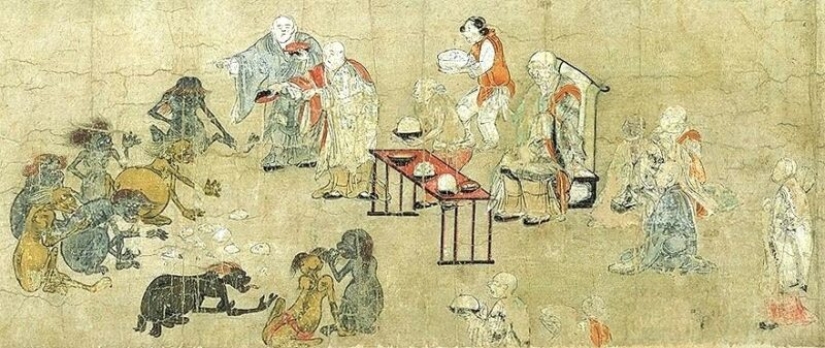
Gaki were described as ugly creatures with deformed heads, tiny sucker mouths, and huge bloated bellies. This is the lowest class in the world of evil spirits, always hungry and not disdainful in search of food, even feces. On occasion, the gaki can also attack a person weakened by hunger or illness. Legends say that bad, greedy and envious people turn into these spirits after death.
Many Japanese guidebooks and even maps until the early 19th century were issued with a travel guide that strongly advised carrying food for hungry mountain spirits. The legends of the "hungry gods" have proved so tenacious that in some areas residents will be happy to show the curious tourist places where dangerous ghosts can hide. Of course, they themselves will not accompany the guest to a dangerous place.
One of these places for many centuries inspires fear among the villagers of Wakayama Prefecture. There, between the Okumotori and Shokumotori Mountains, there is a deep rock grotto where, according to legend, evil spirits live. You can also find small shrines on the mountain roads of Japan, near which the traveler can pray for good luck on the way, and if necessary, then escape from the attack of aggressive evil spirits near them.
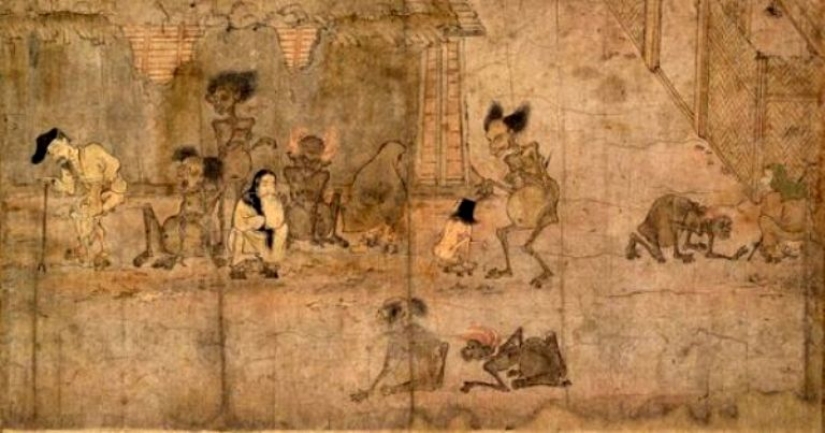
Some ethnographers believe that the legends about hiduragami go to the regions of the country, once severely affected by famine. Many stories about hiduragami may have originated from cases of cannibalism in remote mountain areas. But this version does not explain why the legends of the "hungry gods" are popular in some rich areas, where the fact that such a famine has not been heard of for centuries.
Keywords: Mountains | Culture | Asia | Japan | Sacrifices | Rice | Famine | Myths | Ghosts | Monsters
Post News ArticleRecent articles

For many of us, going to the dentist is a nightmare experience. And this despite anesthesia and other modern technologies. It is ...

Talented photographer and retoucher Daria Klepikova lives and works in Moscow. Daria specializes in portrait photography and travel ...
Related articles

The term "photography" appeared at the beginning of the XIX century, but the history of this art form has its roots in much more ...

Every country in the world is associated with a certain smell. India is remembered by the aroma of spices, France-the smell of ...

The project of the artist Valery Barykin "Soviet pin-up" is, first of all, retro, not burdened with criticism of the regime or ...

Sometimes even great talent is forgotten. This is precisely the situation faced by the wonderful French artist Jean-Léon Gérôme, ...